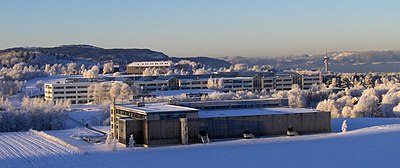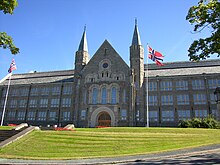Technical and Natural Science University of Norway
| Technical and Natural Science University of Norway | |
|---|---|

|
|
| founding | 1996 |
| Sponsorship | state |
| place | Trondheim , Norway |
| Rector | Anne Borg |
| Students | 42,031 (2018) |
| Employee | 7,401 (2018) |
| Annual budget | 9.4 billion NOK - 933 million euros (2019) |
| Networks | CESAER , TIME |
| Website | ntnu.no |
The Technical and Natural Sciences University of Norway - NTNU ( Bokmål Norges teknisk-naturvitenskapelige universitet , Nynorsk Noregs teknisk-naturvitskaplege universitet ) based in Trondheim is the largest university in Norway with around 42,000 students . The NTNU has primary responsibility for technological research and teaching in Norway.
history
The history of the NTNU goes back to the Royal Norwegian Scientific Society , which was founded in 1760 under the name Det Trondhiemske Selskab .
In 1900 the Norwegian Parliament decided to found the Norwegian Technical University , following the example of the German technical universities . Ten years later, in 1910, the Norwegian Technical University opened. This is how the history of the NTNU as a training institution began.
The university was founded in 1996 through a merger of several Norwegian universities. On January 1, 2016, Høgskolen i Sør-Trøndelag and the universities in Gjøvik and Ålesund were incorporated . This made the NTNU the largest university in Norway.
They award the Onsager Medal .
organization
Faculties
NTNU has a total of eight faculties and 55 institutes:
- Faculty of Medicine and Health Sciences
- Faculty of Humanities
- Faculty of Architecture and Design
- Faculty of Information Technology and Electrical Engineering
- Faculty of Engineering
- Faculty of Social Sciences and Education
- Faculty of Science
- Faculty of Economics
The university offers around 340 degree programs and more than 30 international master’s degrees in English .
Students and staff
There are currently 42,000 students studying at NTNU. About half are technical and scientific students. Approximately three-quarters of Norway's master's degree students in science are enrolled at NTNU. Around 35,500 of them are in Trondheim , around 4,000 in Gjøvik and 2,500 in Ålesund . In 2018, a total of around 3,500 students came from abroad. There are currently around 38,000 alumni in total .
The university has 7,400 employees, 4,800 of whom are academic staff. The university is headed by an employed and unelected rector. The rector is supported by three vice rectors. The physicist Anne Borg has been acting rector since August 2019.
campus
NTNU has several campuses in Trondheim. The two largest of these are Gløshaugen and Dragvoll . Gløshaugen is the former NTH (Technical University of Norway), where all technical and scientific faculties are located. The faculties of humanities and social sciences are in Dragvoll, which is just outside the city. There are also campuses in Ålesund and Gjøvik.
research
Institutes
NTNU has three of the 13 so-called "Centers for Excellence in Research" in Norway, which were started as part of an initiative by the Norwegian Research Council in 2003 to raise research to an international top level.
- Center for Quantifiable Quality of Service (Q2S)
- Center for Ships and Ocean Structure (CeSOS)
- Center for Biology of Memory (CDM)
In 2007 the Center for Biology of Memory also became the Kavli Institute for Systems Neuroscience . A great recognition that so far mostly American top universities such as Harvard University , Stanford University , Yale University , Caltech and Massachusetts Institute of Technology (MIT) have received. NTNU is the third European university to receive a Kavli Institute .
Cooperations
- The NTNU works closely with SINTEF , one of Europe's largest independent research institutes, and the St. Olavs University Hospital.
- The NTNU participates in the NordicFiveTech, a collaboration between five Nordic technical universities: Chalmers University of Technology , Royal Institute of Technology Stockholm , Helsinki University of Technology and Technical University of Denmark . They offer a Nordic M.Sc degree in Sustainable Energy Engineering in cooperation .
- Besides the Nordic cooperation, NTNU also has many partners in the United States, Europe and Asia (mainly Japan , China and Singapore ). A collaboration of great importance is the collaboration with MIT in the field of energy research. The Faculty of Social Sciences has also initiated a collaboration with the University of California, Berkeley (UC Berkeley). Each semester, up to 50 students can study at UC Berkeley.
- The NTNU has a research collaboration with around 200 universities worldwide and supports the yr.no weather service with data.
Nobel Prize Winner
- Lars Onsager (1903–1976), graduated in 1925, Nobel Prize in Chemistry 1968
- Ivar Giaever (* 1929), graduated in 1952, Nobel Prize in Physics in 1973
- May-Britt Moser and Edvard Moser , university professors, Nobel Prize in Physiology or Medicine 2014
Web links
- http://www.ntnu.no - Official website
- http://www.ntnu.no/vitenskapsmuseet - Science Museum of the NTNU
- Entry on snl.no in the store norske leksikon (Norwegian)
Individual evidence
- ↑ Technical and Natural Sciences University of Norway (Ed.): Rector and Rector's management team. accessed on October 9, 2019.
- ^ Om NTNU. In: ntnu.no. Retrieved October 10, 2019 (Norwegian).
- ↑ The largest study locations in Norway. Retrieved March 3, 2020 .
- ^ Christian Fossen: Tall - fakta. Retrieved October 10, 2019 (Norwegian Bokmål).
- ^ Christian Fossen: Campuses. Retrieved October 10, 2019 .
Coordinates: 63 ° 25 ′ 0.4 ″ N , 10 ° 24 ′ 17.1 ″ E

